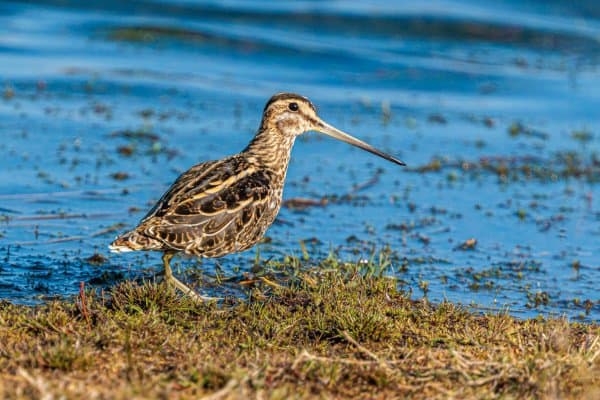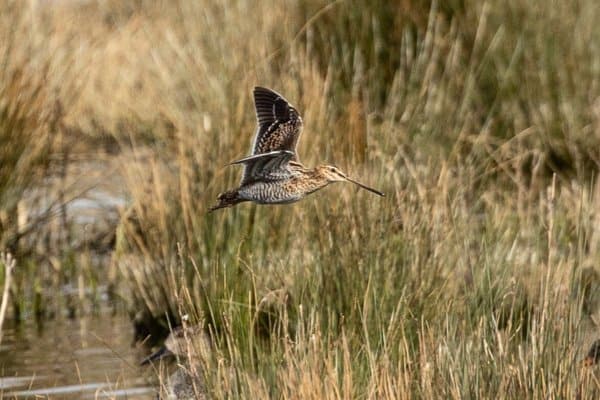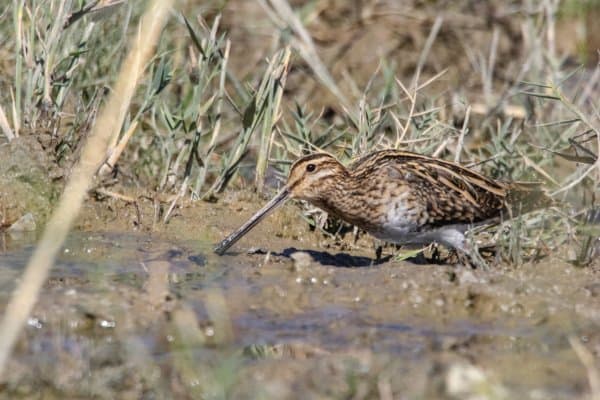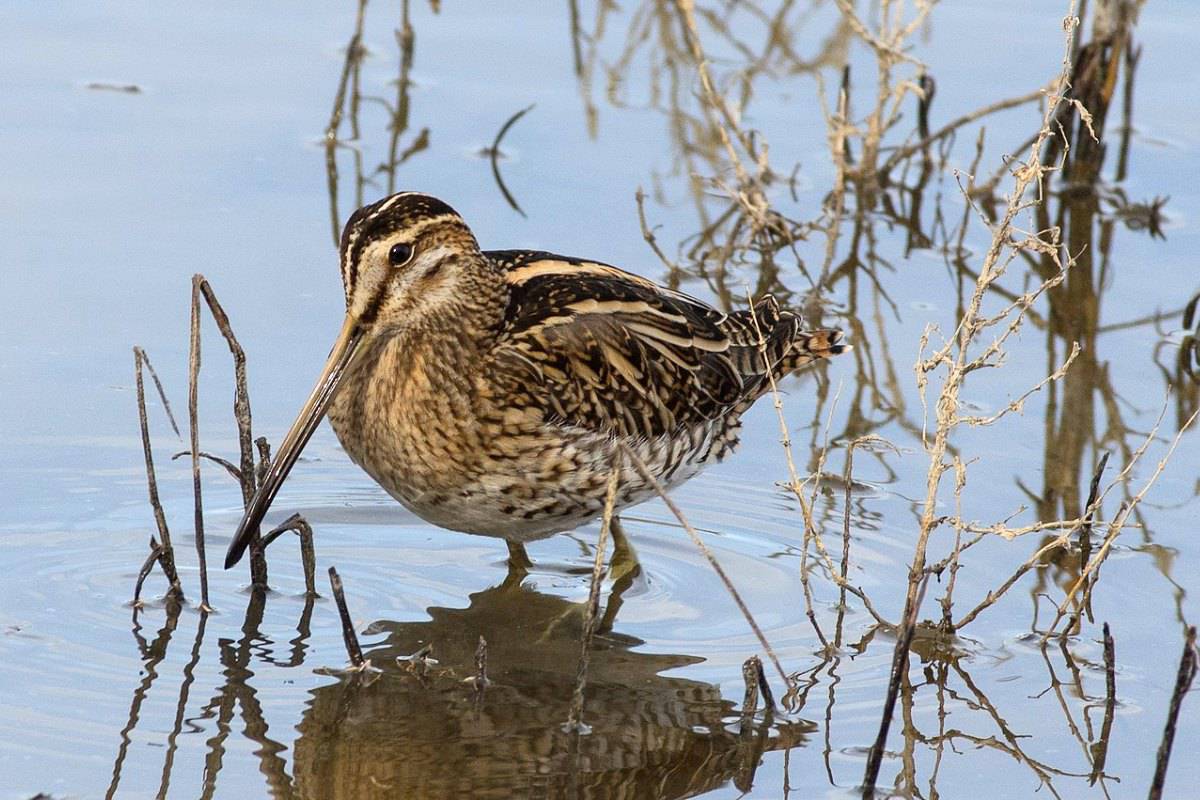Common Name: Common Snipe
Scientific Name: (Gallinago gallinago)| Size | Diet | Range in Hawaii | Status in Hawaii |
|---|---|---|---|
| 10 in. - 12 in. | worms, small crustaceans, and insect larvae | O'ahu, Kaua'i, and Maui | Least Concern |
The Common Snipe, also known as Gallinago gallinago, is a medium-sized wading bird species native to Europe, Asia, and North America. While the species is not native to Hawaii, it has been known to visit the islands as a non-breeding visitor and vagrant occasionally. With its unique appearance and distinctive behavior, the Common Snipe is a fascinating bird species that has captured the attention of birdwatchers and avian enthusiasts worldwide.
In this article, we will explore the world of the Common Snipe, its unique characteristics, and its occasional presence in Hawaii.
Common Snipe
Appearance

The Common Snipe is a remarkably designed bird known for its distinctive appearance. This medium-sized wader typically measures around 10 to 12 inches in length. One of its most striking features is its long, slender bill, which is highly sensitive.
Common Snipes have cryptic brown plumage and often display a series of intricate dark bars and stripes on their back, helping them blend seamlessly into the reeds and grasses where they forage. Their underparts are lighter in color, with a subtle buff or white tone. In flight, Common Snipes reveal a striking pattern of white patches on their wings.
Diet
The Common Snipe boasts a fascinating and highly specialized diet. These birds are true masters of the marshes and wetlands, where they employ their long, sensitive bills like precision tools. Their primary menu consists of a delectable assortment of aquatic invertebrates, such as worms, small crustaceans, and insect larvae.
Nesting
The nesting habits of the Common Snipe are a testament to nature’s ingenuity. These birds prefer to construct their nests in concealed, secluded spots within their wetland habitats. Their nests are carefully concealed amidst dense vegetation, providing not only protection but also a sense of privacy.
Common Snipe nests are typically built on the ground, with the female crafting a shallow depression in the marshy or grassy substrate. To add an extra layer of camouflage, she often lines the nest with bits of vegetation to blend seamlessly with the surroundings.
These birds are quite secretive during the nesting period, and they rely on their cryptic plumage and stealthy behavior to avoid detection. If an intruder gets too close to their nesting site, they may employ distraction displays or even feign injury to draw attention away from their precious eggs.
The eggs themselves are a work of art, usually olive or buff in color, speckled with intricate markings that further aid in camouflage. Common Snipe parents take turns incubating the eggs, and once the chicks hatch, they are precocial, meaning they are born with their eyes open and are relatively self-sufficient.
Behavior

The Common Snipe exhibits a captivating blend of behaviors that reflect its adaptability to its wetland habitat. These birds are masters of camouflage, seamlessly disappearing amidst the reeds and grasses. When startled, they take to the air with dramatic, zigzagging flights, proving elusive to both predators and birdwatchers.
During the breeding season, male Common Snipes perform an enchanting “winnowing” aerial display to court females. Their preference for crepuscular and nocturnal foraging helps them avoid diurnal threats while capitalizing on abundant invertebrates during dawn and dusk.
Common Snipes are often solitary, territorial during breeding, and choose concealed nesting sites, employing distraction tactics if intruders approach. Their migratory journeys span thousands of miles, showcasing their impressive navigation abilities. The behavior of the Common Snipe is a testament to its remarkable survival strategies and makes it a captivating subject for nature enthusiasts.
Habitat

The common snipe calls the tranquil wetlands and marshes home. Its cryptic plumage blends seamlessly with the lush reeds and mudflats, making it a master of camouflage. The habitat of the common snipe is a treasure trove of biodiversity and natural beauty, offering a glimpse into the intricate tapestry of life in wetlands.
Range
The Common Snipe is a rare visitor to Hawaii, primarily seen during its non-breeding season. In Hawaii, there have been confirmed sightings of Common Snipes in the Northwestern Hawaiian Islands, with records at Kure and Midway.
Additionally, there have been marginal considerations of sightings in the Southeastern Hawaiian Islands, including O’ahu, Kaua’i, and Maui. These sightings provide a unique opportunity for bird enthusiasts to witness this extraordinary species in a far-flung part of the world.
Conservation Status
The common snipe (Gallinago gallinago) was classified as “Least Concern” on the International Union for Conservation of Nature (IUCN) Red List. This designation indicates that the species was not considered to be facing imminent threats of extinction.
Interesting Facts
1. Global cultural significance
The common snipe has been a part of cultural folklore in many regions. It has inspired myths, stories, and even phrases like “snipe hunt,” which refers to a practical joke where people are sent on a wild goose chase to catch a snipe that doesn’t exist.
2. Distinctive eye stripe
One of their distinguishing features is the bold white stripe that runs above each eye, contrasting with their otherwise cryptic plumage. This eye stripe gives them a distinctive appearance.
3. Variability in size
Common snipes exhibit sexual dimorphism, with males typically being slightly larger than females. However, there is considerable variability in size among individuals, making precise identification challenging in the field.
4. Courtship jumps
During courtship, male common snipes engage in a unique behavior known as “jumping.” They leap into the air and perform exaggerated leaps and twists to impress potential mates.
5. Keystone species
Common snipes play a vital role in wetland ecosystems by controlling insect populations and contributing to nutrient cycling through their feeding habits. Their presence is an indicator of the health of wetland habitats.
Frequently Asked Questions
1. Are common snipes good swimmers?
Common snipes are not strong swimmers, and they usually avoid deep water. However, they are skilled waders and can navigate shallow water and mudflats with ease.
2. What is the lifespan of a common snipe?
Common snipes can live up to 8 to 10 years in the wild, depending on various factors such as predation, habitat quality, and environmental conditions.
3. How do common snipes communicate with each other?
Common snipes use a variety of vocalizations to communicate, including the distinctive “scaipe” call during their aerial displays. They also produce “chip” sounds and other calls during courtship and territorial interactions.
4. How do common snipes adapt to winter conditions in colder regions?
In some regions with cold winters, common snipes may adapt by growing thicker and more insulating feathers to cope with the colder temperatures. They may also change their foraging behaviors to find food in frozen or snowy conditions.
5. Can common snipes be kept as pets?
Keeping common snipes as pets is generally not recommended or legal in many regions, as they are wild birds that require specific habitats and diets. Conservation laws often prohibit their capture and domestication.




